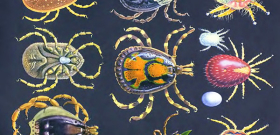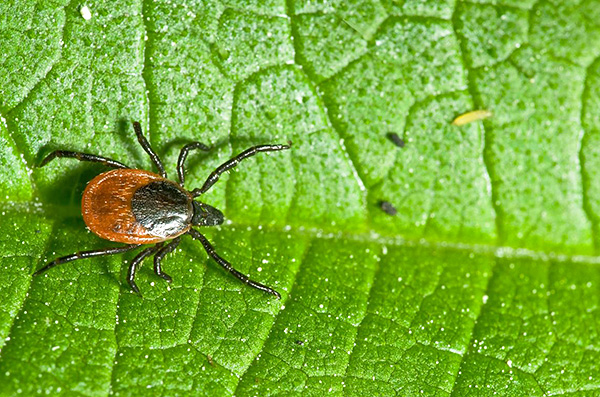
Speaking in general, a large number of the most diverse types of ticks live in the forests. Some of them are saprophages - they inhabit rotting litter and upper layers of soil (Oribatidae), many species live on plants and feed on the contents of the cells of leaves and shoots of woody and herbaceous plants (Tetranychidae).
However, there are ticks in the forests that parasitize animals at a certain stage of their life cycle. It is these blood-sucking ticks (Ixodidae, otherwise - Ixodes) that are dangerous to humans, their development is invariably associated with the need for nutrition, including on humans.
The fauna of ixodid ticks in Russia is rich and includes dozens of species, however, in medical and veterinary terms, the most important are dog tick (Latin name Ixodes ricinus, aka European forest tick), taiga tick (Ixodes persulcatus) and wood ticks of the genus Dermaceptor. They are carriers of such dangerous human diseases as tick-borne encephalitis, Lyme disease, tularemia and rickettsiosis.
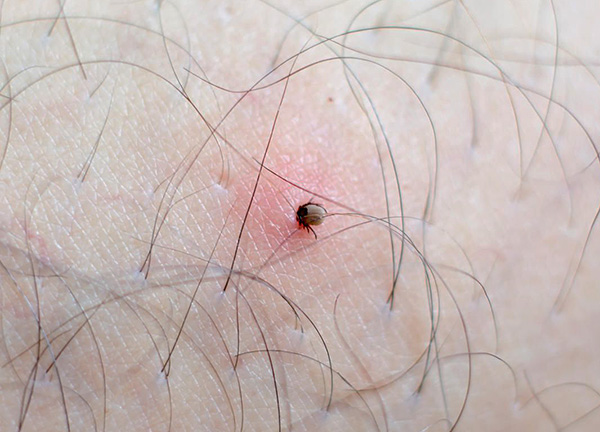
ixodid ticks are distributed everywhere and are found in different types of forests throughout Russia. However, within the same biotope (pine forest, oak forest, deciduous forest edge, artificial forest plantations), their distribution and abundance can vary greatly.This is explained by the fact that such forest mites are external parasites, therefore they are highly dependent on the climatic features of a particular territory.
To summarize, we can say that in any forest there are such areas where there are a maximum number of ticks due to the fact that the most favorable conditions for them have been created there (temperature, humidity, illumination, the presence of hosts), so there may be a chance to pick up bloodsuckers very high.
Let's see where ticks live, what kind of forests they prefer, where the number of these parasites reaches its maximum, and also talk about how to effectively protect yourself from these dangerous parasites ...
What ticks are the most dangerous in the forest
It is the dog and taiga ticks that parasitize humans more often than all the others and, most importantly, they carry a number of dangerous diseases. Therefore, these mites are given priority.
These parasites are found in all types of forests in our country, but their species diversity and abundance vary depending on the natural zone. For example, Ixodes ricinus is confined to well-lit broad-leaved and coniferous-deciduous forests, where it prefers moist, sun-warmed areas. This species is distributed south to the semi-desert zone.

Ixodes ricinus
Ixodes persulcatus, on the contrary, is confined to coniferous forests, and is much less common in mixed forests. In the steppe zone, the taiga encephalitic tick is completely absent.
The photo below shows an adult female taiga tick Ixodes persulcatus:

And this is what a male looks like:
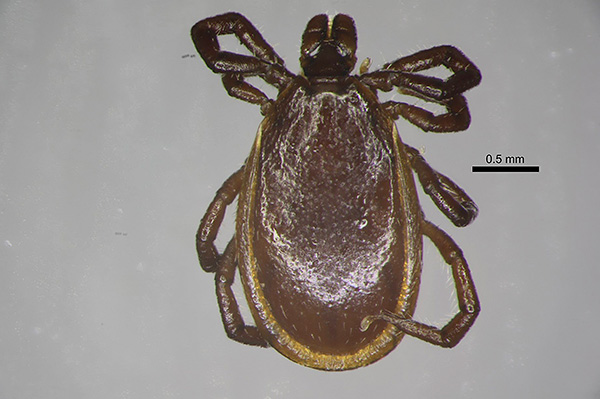
On a note
Representatives of the genus Dermaceptor, also feeding on blood, are distributed throughout Asia, Europe, reaching the shores of the Pacific Ocean. In the north, the habitat reaches up to the taiga zone.Dermaceptor spp. found in broad-leaved and mixed forests of various types. Preferred habitats are meadows with high succulent vegetation. They do not inhabit open steppe areas.
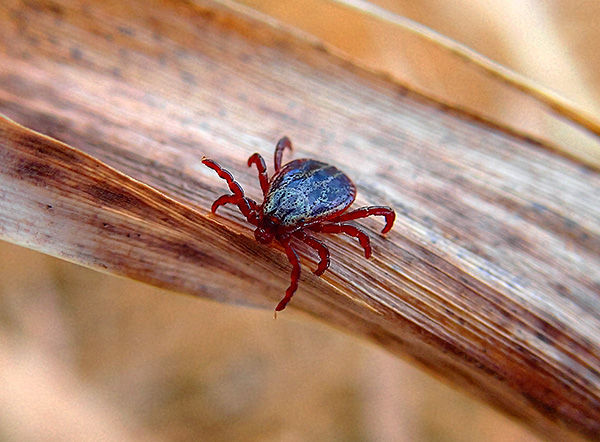
Dermacentor reticulatus
So it is quite difficult to determine in advance which forest will have the most ticks. Be that as it may, being in nature, you should know the places where parasites are likely to concentrate.
There is a nuance here: in relation to ticks, as well as among insects, the so-called “law of change of stations” operates - with the advancement of the range to the south, the need for moisture increases. Therefore, if in the taiga the taiga tick will look for dry, well-heated areas, then in the zone of mixed and broad-leaved forests, the accumulation of parasites will be observed in shaded, humid and rather cool places. This should be taken into account when choosing places for recreation in the forest.
Nutrition of parasites and their danger to humans
All forest ixodid ticks are external blood-sucking parasites, which are characterized by long-term feeding. They spend the most important stages of their lives on the body of the host.
Life cycle parasite is directly related to the change of host. If a tick at a certain stage of its development does not find a new victim, then after a while it dies. That's why spring and autumn forest ticks are very active and literally bloodthirsty, as they strive to get enough to continue development.

All types of life cycles of ixodid ticks can be divided into 3 groups:
- three-host;
- two-host;
- single-host.
At three-host type of parasite development only feeding individuals are on the host, and molting of immature stages, wintering, copulation and oviposition occur in the external environment. Most of the ixodids belong to this group.
With a two-host type of development, the larva sticks to the host, molts on it, and the already well-fed nymph disappears. This markedly increases the parasite's chances of survival, as the nymph will not starve. Most often, this type of development is observed in parasites of ungulates.
The single-host type of life cycle is the most evolutionarily advanced, when all stages of development occur on the host: an already fed female disappears, which will lay eggs in the environment. Such a cycle is characteristic of highly specialized blood-sucking mites that are closely associated with the prey, and often live in their burrows or nests.
The most dangerous tick species for humans (dog and taiga) have a three-host type of development. At the same time, the timely change of hosts is very important - at each stage of the life cycle, the parasite must be satiated, so ticks are in constant search of a host.
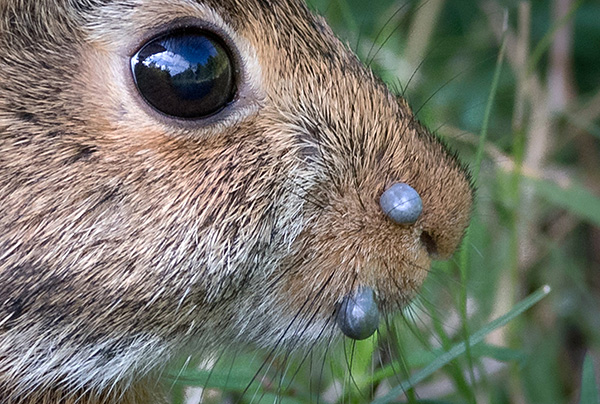
Small larvae that have just emerged from the eggs attach themselves to lizards, birds, and small rodents. Nymphs choose larger victims: squirrels, hares, dogs, cats, foxes. Adults often parasitize cattle, dogs, wild boars, elks, deer, often stick to a person.
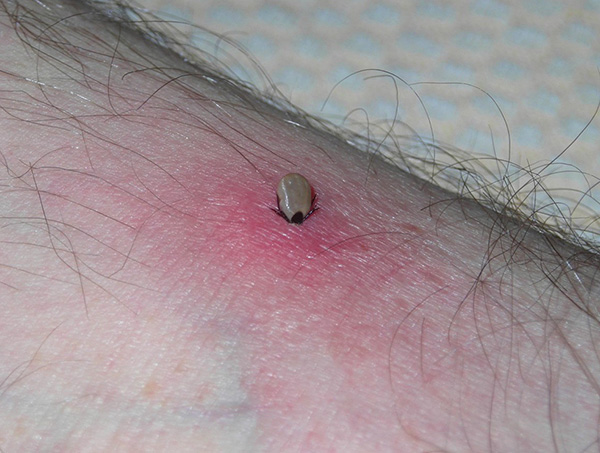
Such a repeated change of owners entails the transmission of dangerous diseases in the circle of hosts. The more often the parasite feeds, the more likely it is that it will become a carrier of pathogens of such dangerous diseases as tick-borne encephalitis and Lyme borreliosis.
Wild animals that live in the forests are carriers of the corresponding pathogens, a kind of living reservoirs that have developed resistance to pathogens. Together with the blood, these pathogens enter the tick's stomach, and in the process of subsequent feeding, along with the parasite's saliva, the infection also enters the victim's body.
On a note
That is why it is highly undesirable to press on the body of the tick when removing the attached parasite from the skin: with strong pressure, additional portions of infected saliva enter the wound. The more saliva gets in, the higher the likelihood of a subsequent development of the disease.
See also important nuances in the article First aid for a tick bite in humans.
About what diseases ticks carry, it is worth talking separately ...
Diseases carried by wood ticks
Forest ticks are mechanical carriers of pathogens of a number of dangerous diseases in humans and domestic animals. As already noted above, during blood-sucking, pathogens from wild animals also enter the digestive system of the parasite along with their blood, which the parasite transmits to the subsequent host when it feeds again.
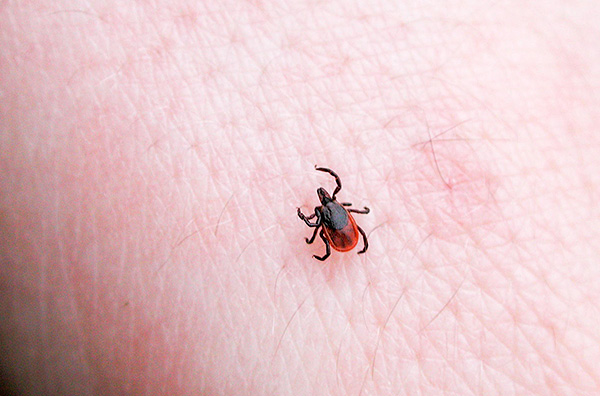
There are dozens of tick-borne diseases by specialists, but we will note only the most dangerous of them:
- Tick-borne encephalitis (sometimes also called spring encephalitis) is a natural focal viral disease, which is primarily characterized by damage to brain tissue. The disease can lead to irreversible neurological and psychological disorders and often to the death of the patient;
- Lyme disease is an infectious disease caused by the bacteria Borrelia burgdorferi.The disease is named after the name of the city in the United States, where it was first noted by doctors. Symptoms of infection are fever, cardiovascular and muscle disorders. The most pronounced sign of infection after a bite borreliosis tick - migrating red annular erythema, which appears at the site of the bite, and later can migrate throughout the body;
- Tularemia is caused by the bacterium Francisella tularensis. Carriers are blood-sucking insects and ticks. The disease is characterized by fever, severe intoxication of the body, damage to the lymph nodes;
- Q fever is caused by the bacteria Coxiella burnetii. A person can become infected from farm animals while working in livestock farms, as well as through the bite of a tick infected in a natural focus. The incubation period lasts from 3 to 30 days. Symptoms are different and individual in nature - it can be headache, nausea, vomiting, fever, bronchitis, pneumonia, etc.
In addition to the above human diseases, ixodid ticks carry bacterial and viral diseases from wild animals to domestic ones.
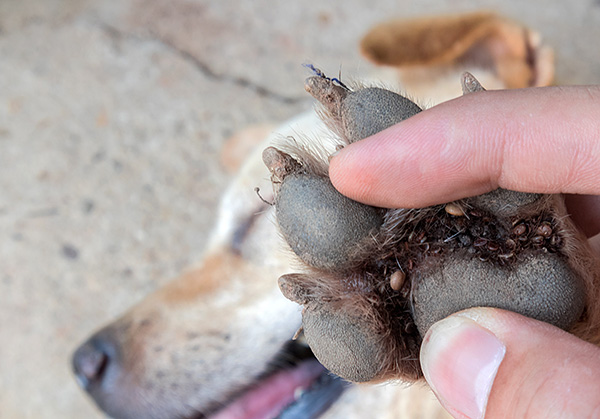
They infect pets:
- brucellosis;
- foot and mouth disease;
- leptospirosis;
- piroplasmosis;
- nuttaliosis;
- anaplasmosis, etc.
All these diseases are extremely dangerous for animals and can lead to the loss of livestock.
Appearance of the parasite
Dog, taiga and other ixodid ticks look similar in appearance to each other (see pictures below). Sometimes even specialists cannot quickly distinguish them without additional thorough research.

The color and size of these parasites can vary widely, from flesh to dark gray or brown. The folds on the covers can sometimes form bizarre patterns, and the soft chitin of the larvae and nymphs is translucent - the color of the blood in the digestive system of the tick is visible through it.
Thus, when trying to determine the species of an attached parasite, it makes no sense to rely only on coloration.
All ixodids also have a similar type of body structure. It consists of a head section (gnathosoma) and a body (idiosoma) - in more detail the structural features can be seen below in the photo:

The idiosoma has the form of a highly extensible sac, due to which the parasite can absorb blood in volumes that are much larger than the size of the body of a hungry individual.
There are four pairs of walking legs on the ventral side of the idiosome (tick larvae have only 3 pairs of legs, so sometimes ordinary people confuse them with insects).
In adults, sexual dimorphism is well expressed: males are very different from females. Firstly, males are much smaller than females, the dorsal part of their body is covered with a dense shiny shield that reaches the top of the abdomen. Because of this, the body of males does not stretch as much as in females, in which the shield reaches only half of the back.
Females are usually larger than males and feed on the host for longer (sometimes adult males do not drink blood at all, and quickly die after mating). It is on saturation with blood that the success of the formation of mature eggs and the continuation of the genus of parasites depend. If for some reason the female did not find a host or disappeared without being fully fed, then the reproductive products will not form inside her, and she will not be able to lay eggs.
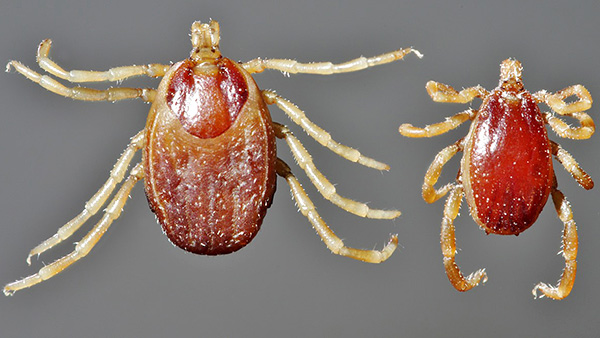
Hyalomma anatolicum (left - female, right - male)
On the head section of the body of the tick, there are simple eyes that perceive changes in light intensity. The main sensitive function is performed by the chemical sense organs located on the paws: it is by smell that the tick finds its prey. Also, bloodsuckers react intensively to heat (infrared radiation), which is scattered from warm-blooded animals.
Of particular interest is the structure of the tick's mouth apparatus, which can only be examined in detail under a microscope. The oral apparatus of the parasite consists of:
- hypostome (proboscis with a halo of hooks);
- pairs of chelicerae;
- pairs of pedipalps.
On the pedipalps are the sensory organs, which were discussed earlier. Chelicerae look like sharp knives that cut through the integument of the victim. The proboscis looks like an elongated harpoon cylinder: when bitten, the parasite completely immerses it in the woundfeeding on blood, lymph and inflammation products.
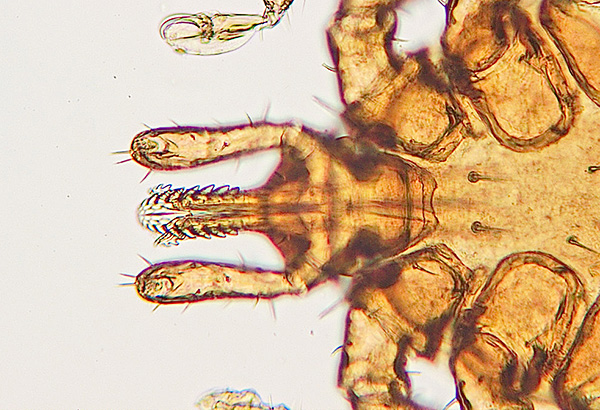
On a note
The tick is very firmly fixed in the wound thanks to the rim of hooks located in longitudinal rows along the entire proboscis. They differ in size and angle of inclination. After entering the oral apparatus, the hooks are firmly fixed in the skin and tissues, especially if you try to pull the parasite out by force. Often, such a procedure ends for the victim with the fact that the proboscis remains in the wound.
Interesting features of the vital activity of forest ticks
Forest (ixodid) ticks are common in all types of forests in Russia, Europe and America. For the main types of ticks, which are of paramount epidemiological importance, maps are provided, where their habitats are indicated. However, the distribution of parasites within the range can vary greatly and depends on a number of factors.

According to the nature of the habitats in the external environment, these bloodsuckers can be divided into 2 groups:
- pasture parasites;
- burrow parasites.
The pasture group includes species that do not have permanent shelters. Ticks with this type of life cycle attack the host in nature, and fall off there - molting, egg-laying and diapause occur in the external environment.
With shelter (burrow) parasitism, ticks spend their entire lives within the nest or hole of the host: here the bloodsucker attacks the host and feeds on it, here falls off and lays eggs.
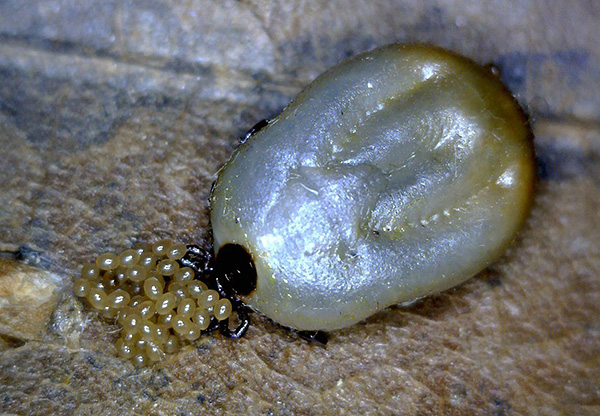
Often it is pasture parasites that parasitize humans, these include dog and taiga ticks. We encounter burrow parasites less often.
It is interesting
Residents of multi-storey buildings sometimes face problems with the presence of blood-sucking mites in their homes when birds (swallows, pigeons, rooks) live in the attic or balconies of their house. Parasites that live in bird nests can crawl into apartments, entrances and bite residents. If for some reason the flock leaves the building, all harmful fauna quickly migrate to warm apartments in search of other hosts.
During each active stage, ticks go through the following phases:
- post-larval development;
- activity;
- food;
- molting;
- oviposition.
During periods of activity, ticks with a pasture type of parasitism lie in wait for their hosts on the surface of the earth, grass, and bushes, where they sit in a characteristic waiting position, putting their front pair of legs forward.
Blood-sucking mites are almost never found on vegetation above a meter and a half distance from the ground. They don't jump from trees.
Larvae live in the ground layer, nymphs are located at a maximum height of 50-70 cm, adults can reach a maximum limit of 1.5 m, but still prefer to sit on lush tall grass (30-40 cm).
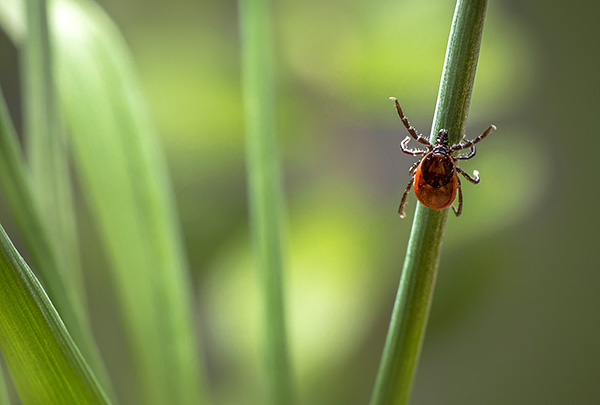
These parasites are characterized by a slight horizontal migration: they may not pursue the prey for a short time or get closer to the animal paths. The main limiting factor is the rapid loss of moisture. After a short activity, the bloodsucker is forced to descend into the upper layers of the soil and absorb moisture.
Ticks don't sleep at night. In the warm season, at night they are sometimes even more active than during the day, since the humidity of the air at night is increased.
The increased sensitivity to the amount of moisture is also explained by the fact that pasture mites predominate in the forest zone, while in the forest-steppe zone and the steppe, most species prefer a burrow lifestyle. Therefore, it is impossible to say that the most ticks are in the forest (park, square, field), but the probability of picking up a tick in the forest zone is really much higher.
The life expectancy of forest ticks differs in different species: on average, it is 2-3 years. The peak of parasite activity occurs in the autumn and spring months (mass reproduction in central Russia was recorded in May and September). in summer and winter bloodsuckers hide in the forest floor, under the bark of trees, as well as in sods of perennial grasses.
What to do if the parasite has stuck
If a tick is found on the body, do not panic. Get rid of the parasite can be done easily at home.
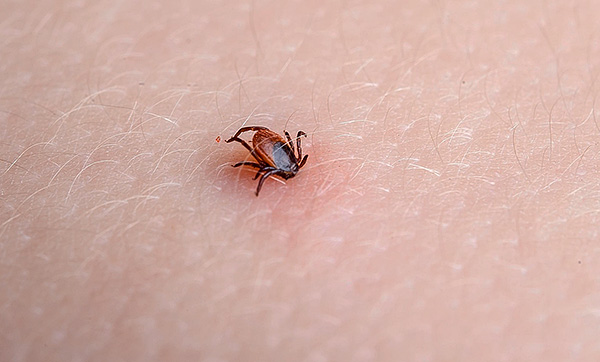
The main thing is to strictly adhere to simple rules:
- Do not expect that the tick will fall off by itself - it must be removed, and the sooner this is done, the better;
- Do not attempt to cauterize the parasite with a match or suffocate it with a drop of oil. This does not work;
- Do not press on the body of the tick with tweezers or fingers (this is how an additional amount of saliva is squeezed into the wound, which may contain pathogens);
- The easiest way to remove the parasite is with a special tick removal device;
- If the tick is not at hand, then you can unscrew the tick with your fingers or thread, making a loop between the gnathosoma and the idiosome. In this case, you do not need to pull sharply, but you just need to twist, gently pulling the parasite out;
- After removing the tick, treat the wound with alcohol (or brilliant green, iodine) and wash your hands thoroughly;
- If the bite occurred in an epidemiologically disadvantaged region for tick-borne infections, then the tick should be placed in a small test tube (or jar) and contacted by a specialized laboratory. There, the parasite is examined for infection with tick-borne encephalitis and borreliosis.
After the incident, you should closely monitor the condition of the victim for at least 3 weeks. At the slightest sign of malaise, it is important to consult a doctor as soon as possible.
For important details, see also the article on incubation period of tick-borne encephalitis in humans.
How to avoid tick bites in the forest
Guaranteed avoid tick bites, if you are in the forest, it can be quite difficult (strictly speaking, almost impossible), but this is not a reason not to let your child go to the park or give up your favorite walks with your pet. There are a number of techniques that can greatly reduce the risk of a tick bite.
The first and most important thing is to use closed light clothes (against a light background it is easier to see a crawling parasite and take it off in time). Pants must be tucked into socks, a jacket into pants, cuffs should fit snugly around the wrists. In this case, once on the trouser leg, the parasite will have to crawl up for a long time, up to the wrists or head. It is advisable to wear a tight-fitting cap, scarf, hat on your head.
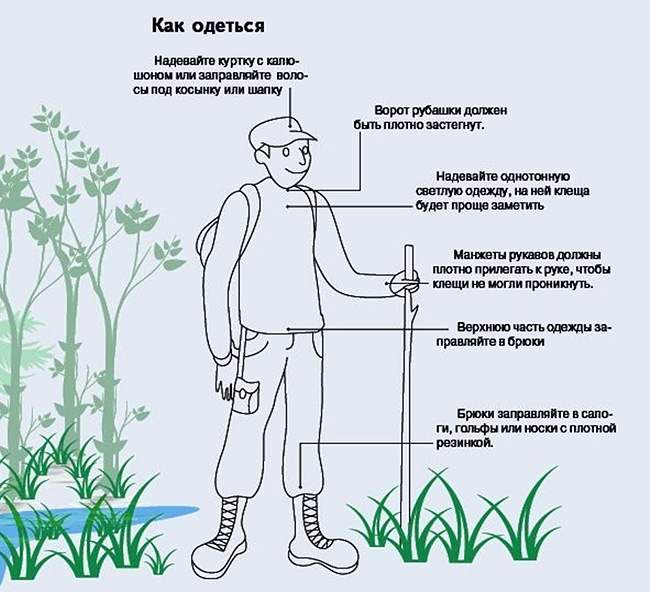
On a note
On sale there are also special anti-mite overalls. They contain the so-called traps for ticks - a kind of small pockets and seams aimed at mechanically delaying parasites.
Being in nature, you should try to avoid potentially tick-infested places: it is undesirable to walk on tall grass in open light glades, along animal paths and pastures. Do not lie on the ground or grass.
For additional protection, it is useful to use tick repellents: many tools have been developed that can effectively scare away and destroy parasites that have attached themselves to clothes. Depending on the composition, some of them are applied only to clothes, others can be applied to the skin. To protect children, you should purchase specialized children's remedies for tick bites.

It is also important to regularly examine yourself and loved ones while relaxing in the forest - the tick is not sucked immediately, and often only a few tens of minutes after it hits the skin.
Are forests sprayed today for ticks?
Now a few words about the mass processing of forests in order to destroy ticks. So, today, unlike the times of the USSR, forests are not pollinated by ticks.
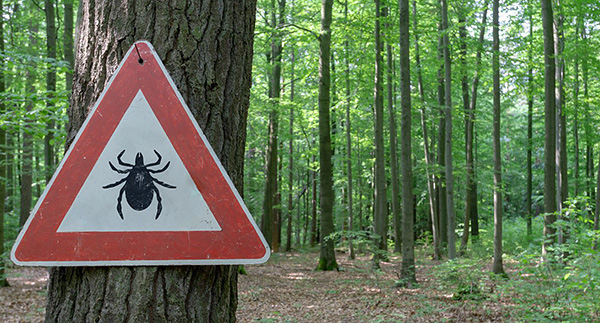
Many people remember how spraying was done in the past. Forests were treated with chemically active substances, which had a very detrimental effect on the state of the ecosystem as a whole.The areas of treatment were colossal, and the mites were quite tenacious, so potent substances were required (you also need to take into account the fact that tick eggs are much more resistant to the action of acaricides than larvae, nymphs and adults).
As a result, along with forest ticks, various species of other invertebrates (some of which, by the way, were natural enemies and regulators of the number of ticks) died en masse. Be that as it may, despite all efforts, the ixodids relatively quickly restored their numbers and their harmfulness.
On a note
Another problem was also noticed - the populations of ticks rapidly developed resistance to commonly used acaricidal agents: there was a constant need to search for more and more new substances.
In the end, experts came to the only correct conclusion: vaccination of the population against tick-borne encephalitis in epidemiological and ecological terms, it is much more rational and productive than total cleaning during acaricidal forest treatments.
Testing different tick protection products

